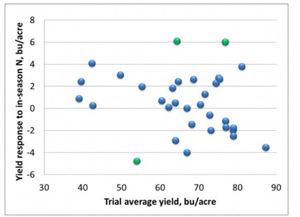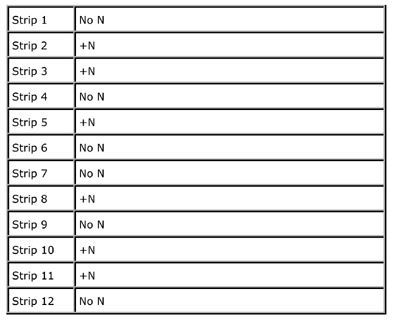|
Soybeans And Nitrogen Fertilizer – Again
DR. EMERSON NAFZIGER
URBANA, ILL.
In April 2014 I wrote on the topic on N fertilizer on soybeans, reporting that our research at the University of Illinois has rarely shown a benefit in yield to applying N fertilizer during the middle part of the season. But it seems that some people, perhaps reacting to testimonials of high yields after using N fertilizer in the high-yield conditions of 2014 remain convinced that adding N fertilizer “makes high yields higher.”
Of course, most producers who got high yields – 20 Illinois counties averaged 60 bushels per acre or more in 2014, with Piatt County reporting an average of 69.2 – did so without using N fertilizer. But the idea that soybeans can’t produce high yields and at the same time fix all of the N that they don’t get from the soil is apparently a compelling one, even though it lacks much supporting evidence.
Our Illinois results
We continued a small amount of work on N on soybeans in 2014, and Figure 1 summarizes the results of 33 comparisons we have run over the past five years. In these trials the N has been applied as urea, urea with urease inhibitor (Agrotain®), and/or polymer-coated urea (ESN) that slows release. Rates have ranged from 100 to more than 300 lb of urea (45 to 150 lb of N) per acre, and applications have been made between first flower (R1) and R4, or full pod stages. I included results from a study where N was both added to untreated plots and where N was left out of a “package” of practices considered to be helpful to high yields.

Yields ranged from 39 to 87 bushels per acre, with an average of 66. We saw significant (statistically likely to have been due to treatment, not just to chance) yield increases in two of the 33 trials, both about 6 bushels above the untreated check, and a significant decrease (of a little less than 5 bushels) in one trial. The average response to using N fertilizer over all 33 trials was a half bushel (increase) per acre. There was no tendency for the response to be higher in higher-yielding trial; the ten lowest-yielding sites showed an average response of about one bushel while the 10 highest-yielding sites showed an average response of only a quarter of a bushel.
These results show that adding N fertilizer can increase soybean yield, but that also that a consistent yield increase is not likely. Getting a yield increase high enough to pay for the practice is also unlikely. The cost of the fertilizer (100 lb of urea is about $23 at the current price of about $460 per ton) plus application means that yields need so increase by 3 to 4 bushels per acre just to break even. Ignoring statistical significance, we saw a yield increase of 3 bushels or more in five of the 33 trials and of 4 bushels or more only three times.
Getting to a real-world answer
The need to find out how often and by how much fertilizer N affects soybean yields provides a perfect opportunity for Illinois farmers and fertilizer retailers and applicators to cooperate in running on-farm strip trials. I included the how-to in an article last spring, but there weren’t many takers. We don’t have funding for this, but I would like to think that there is a group of people willing to cover the costs to make this work. I’m certainly willing to do my part, also without funding. In my vision of the future, this is how agronomic decisions will be made.
Laying out a trial like one to test N fertilizer on soybean is reasonably simple:
• Find a uniform part of a field large enough to accommodate 12 strips wide enough to apply N fertilizer to, and large enough to get accurate harvest yields with the combine. Unless N can be dropped very precisely to strips exactly as wide as the combine will harvest, N strips will need to be wider than the combine. They should be long enough to get a good yield estimate, whether that’s with a yield monitor or a weigh wagon. Record (GPS) coordinates along with soil type, previous crop and its yield, planting date, seeding rate, variety, herbicides, application date, harvest date, and anything else that you think might have affected the crop or the response.
• Assign treatments to strips randomly within each pair of strips. Here is how this might look:

• Apply in-season N to the strips where it was assigned. Timing and form are not fixed, but most will want to use 45 to 90 lb of actual N (100 to 200 lb of urea, possibly including a urease inhibitor; ammonium nitrate at a similar N rate is also an option) applied between stage R2 (full flower) and R4 (full pod). Injected UAN or anhydrous ammonia can also be used if crop size and row spacing allow. If you run over plants to apply by ground, you’ll want to drive (with applicator off) down the “No N” strips as well so all strips experience the same degree of damage. With aerial application, strips will need to be wide enough so fertilizer doesn’t fall into no-N strips. Make certain, either with GPS or with flags (PVC lengths installed using a soil probe work well and are visible), that you know exactly where the N went on and where it didn’t, so you can harvest correctly.
• Harvest and record yields for each strip. Be sure that the width harvested is the same for each strip, and trim the ends after harvest if using yield monitor data. An increasing number of acres are being harvested at an angle to row direction these days, and that won’t work for these trials unless N can be applied at the same angle.
• I’m willing to receive data from trials like this and to send back yield averages after doing stats. If you or an adviser analyze your own, I’d much appreciate getting the data so we can look at this across all sites.
This addresses an important question, and one that will be answered adequately only with on-farm trials like this. It’s especially easy (and without cost) for those who are already planning to apply N to a soybean field in 2015, but we hope that others want to do this as well.
Having a crop on 10 million Illinois acres that doesn’t require N fertilizer is a great advantage under today’s pressures to have crop production remain “sustainable” and to decrease the amount of N going into the rivers. We simply cannot afford to start applying N to large acreages of soybean without knowing if it’s providing a response. We do know that, at least in some years, fertilizer N applied in July or early August won’t all be taken up by the crop, and that part of any N from fertilizer left in the soil after soybean harvest will end up in tiles lines. Can we afford that?
I’d be glad to hear from anyone with questions about this, and from those who are interested in running a trial or two in 2015. ∆
DR. EMERSON NAFZIGER: Research Education Center Coordinator, Professor, University of Illinois
|
|